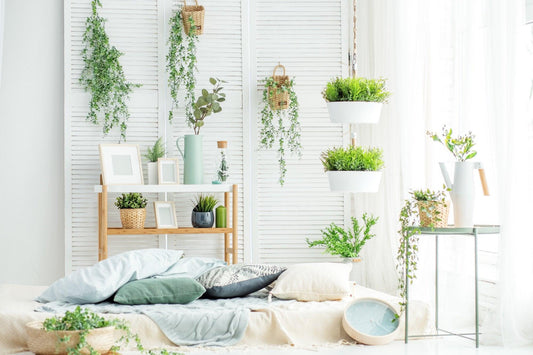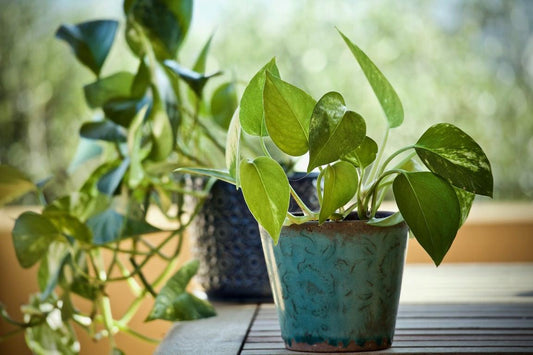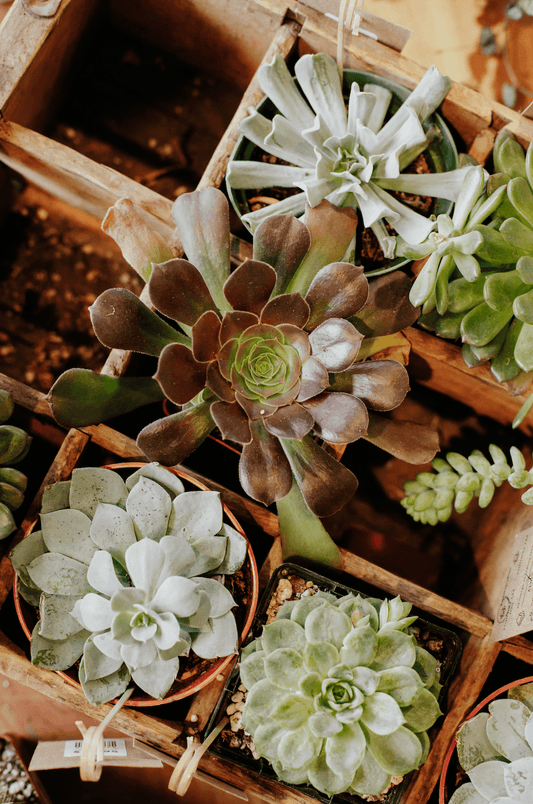Pothos
How to Care for Pothos
Overview
Pothos, also known as Devil’s Ivy, is a really great houseplant for beginners. Most likely, you’ve seen it trailing in your parents’ house, your friends’ houses, your grandparents’ houses, an office setting, and more. They’re a very common and popular plant because they’re easy to care for and can survive in less-than-ideal conditions. They’re forgiving plants, and also very communicative in what they need.
Pothos grow rather quickly if taken care of correctly. These trailing plants produce long vines, and do well in hanging baskets. These can get a bit wild, so many people choose to prune or take cuttings from the longer vines to be propagated. Because of this, pothos are great plants to share with friends, and are a gift that keeps on giving.


Profile
Pothos are known to put out aerial roots along their vines. Aerial roots are roots that grow above the soil and function as anchors. These aerial roots allow for pothos to be trained to climb a pole, a wall, etc. if you so choose.
Pothos are kept for their foliage and will most likely not flower as a houseplant.
Efficient at cleaning the air of harmful chemicals, pothos are natural, living air purifiers. They make for a healthy and beautiful addition to your home. Pothos are have insoluble calcium oxalates which are irritating to pets and humans, so don’t throw these heart-shaped leaves into your salad or let your pet munch on them.




Low light
Pothos prefer a bright area to live in, but not direct sunlight. They can survive in low light or only under fluorescent lights, as you might find in an office, but they will grow faster and be happier in bright, indirect light. If your pothos is of a variegated variety, the color differences will be more pronounced in brighter light conditions.

Occasional
Your plant will let you know when it needs water when the leaves begin to droop, but it’s best to pay attention to your pothos before this happens. Pothos like a moist soil but don’t like to sit in water. Grab your watering can when the soil is 50-85% dry, and water until the water begins to come out the bottom of the drainage holes, maing sure to discard an excess standing water.

Easy breezy
FREQUENTLY ASKED QUESTIONS (FAQs)
on Pothos
Why is my pothos turning yellow?
There are a few reasons why your pothos could be turning yellow. The most common is overwatering. Let the soil dry out before watering again and consider moving to a sunnier spot if it's being kept in low light. If the problem persists, you might have root rot; take a cutting, if this is the case, to start a new plant.
Pothos can also turn yellow if they’re underwatered. This is accompanied by crispy leaves. Check the soil to see if it needs a drink.
Leaves can also turn yellow because of a nutrient deficiency or old age. Allow the leaves to fully turn yellow before snipping them off, and consider re-potting into a more nutrient rich potting mix or a larger pot.
Why is my pothos drooping?
Similar to why it might turn yellow, drooping can happen if pothos are overwatered or underwatered.
If your pothos is overwatered, the leaves will be limp to the touch, droop, and/or turn yellow. These are signs of root rot. If your pothos is thirsty, the leaves will curl in on themselves and droop. Give it a nice thorough drink if this is the case.
Paying attention to your pothos is very important in diagnosing why your pothos is drooping. Is the soil very wet or dry? Are the leaves crispy or floppy? What color are the leaves? These are questions you can ask yourself that will help diagnose the issue.
How do I take a cutting from my pothos? How do I propagate the cutting?
Aerial roots come in handy here. Pothos have much better chances of rooting with stem cuttings rather than just a leaf.
First, find an aerial root or a node along the stem. They will be fairly close to the leaf. With a clean, sharp pair of scissors or shears, cut the stem right behind the aerial root/node. You’ll want this cutting to have a few leaves, but remember to leave some behind on the parent plant to ensure every pothos, new and old, stays looking beautiful.
With this cutting, you can begin to propagate. Although mature pothos plants don’t like sitting in water, pothos cuttings are more than happy to! One of the easiest ways to propagate a pothos cutting is to just stick it in a glass of water, making sure the node is fully submerged. There are many beautiful glass vases, jars, and vials out there that are made for propagating plants like pothos.
Place your propagation station on a sunny window sill and wait for roots to start growing. Allow them to grow out a little before transferring them to soil. Make sure to change your water weekly to allow fresh oxygenaion for your plant to develop roots.
If you don’t want to propagate with water, putting the cutting straight into dirt to root works, too.




